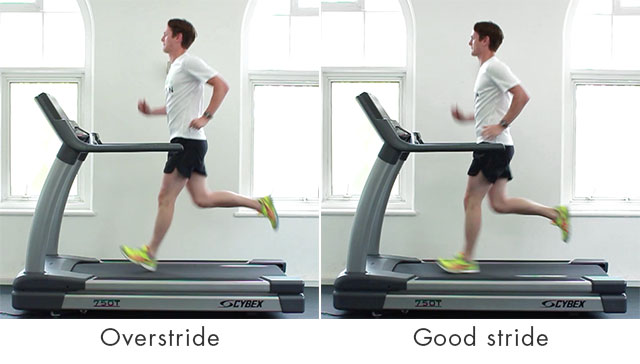
How to Improve Your Running Form
Thursday, January 17, 2019
In my last blog entry I showed you how to pick the best pair of running shoes to improve your overall performance and reduce the chance of injury. This post will teach you to enhance your running experience without putting in long hours or excessive mileage. That’s because running is a skill that can be improved through simple drills that help boost your economy and efficiency. Plus running fast is all about feel, and learning what adjustments you need to make yourself quicker can lead to PR’s and Podiums down the road.
Stride It Out
One of the biggest issues I see with athletes on a regular basis is not placing their foot directly underneath the body while running. This causes a major braking effect to occur since the foot landing out in front of the Cetner of Mass produces a stop and start effect to occur with every stride. Which not only slows you down, but increases the impact on your muscles and joints that can lead to injuries.
I use the clawing motion of the B Drill to work on placing the foot directly underneath the Center of Mass for the body. The cue I tell my athletes to concentrate on is “Knee Up, Toe Up”, while focusing on the ball of the foot contacting the ground and rolling effortlessly forward into the next stride. Learning to use your body weight more efficiently is the key to running fast and injury free.
Arms Race
It is incredibly important to use your arms, since they dictate how fast your legs will go by coordinating with the B Drill clawing motion and hip extension for a strong “get away” step. Along those lines, Nike sports scientists created a sling that their runners used while training for the first sub 2 hour marathon. It helped keep their arms at a right angle and did not allow them to cross the mid-line of the body (affectionately dubbed the T-Rex).
I have my athletes practice proper mechanics by sitting on the ground and swinging their arms straight back from the elbow, while allowing theirs hands to easily flow straight forward. This will also help eliminate any excessive rotation, which in turn will make you faster since there no wasted side to side movement or extra ground contact time required to stabilize the hip to produce forward momentum.
Onward Not Upward
Another major issue I observe with runners is too much up and down motion in their stride pattern. This can be partially attributed to athletes performing the A Drill or High Knee exercise like a football player running through an Agility Ladder, pooping their knees up and down furiously like pistons. But it is critical to remember that everything in running is based around the principle of action/reaction, and thus your knee should move away from the body so your hips will flow naturally forward and not up and down.
For example, just an inch of bounce with every step can equate to an extra mile of up and down motion traveled during a marathon. Thus I get my athletes to eliminate wasted motion by focusing on everything in their body moving forward, which translates to more energy for faster times.
Fast is Relaxed
Finally, you need to periodically evaluate the muscles in your body to make sure you are loose and relaxed. This includes your face, shoulders, and hands, while using techniques like progressive muscle relaxation combined with “belly breathing” to help reduce stress and tension that can slow you down. I also tell my athletes to smile while they are running, since research shows that it reduces muscle tension and distract runners from bodily sensations like fatigue and general discomfort.
But it is also essential for fast running to learn how to breathe deeply from your diaphragm, while activating the parasympathetic nervous system to help put you into a more relaxed state for better performances. I teach my athletes how to breathe properly by placing one hand on the upper part of the chest, and the other on their belly. You then breathe deeply through your nose while using the diaphragm to produce a relaxation response that can lower your heart rate and reduce muscle tension. I then integrate the breathing into a nightly meditation practice that includes visualization and positive affirmations.
About the Author: Dr. Timothy Moore
Timothy J. Moore, Ph.D., C.S.C.S., M.C.H.E.S., is a health and fitness consultant with over 30 years of experience, having worked with top organizations such as the Kerlan-Jobe Orthopaedic Clinic and US Fitness Holdings. As a Former Division I athlete and track coach at the University of Maryland, Dr. Tim has coached collegiate All-Americans, top professionals, and world champion senior competitors, as well as life coaching clients that include celebrity entertainers and Fortune 500 executives. Dr. Tim has also served on the Personal Trainer Exam Committee for the American Council on Exercise, as the Fitness Editor for Shape magazine, and as a consultant to sporting goods companies such as Reebok. While features on Dr. Tim have appeared in People magazine and USA Today, as well as on television’s Good Morning America. Finally, for his work in the industry Dr. Tim was honored by being named to the prestigious Who’s Who in the World.
